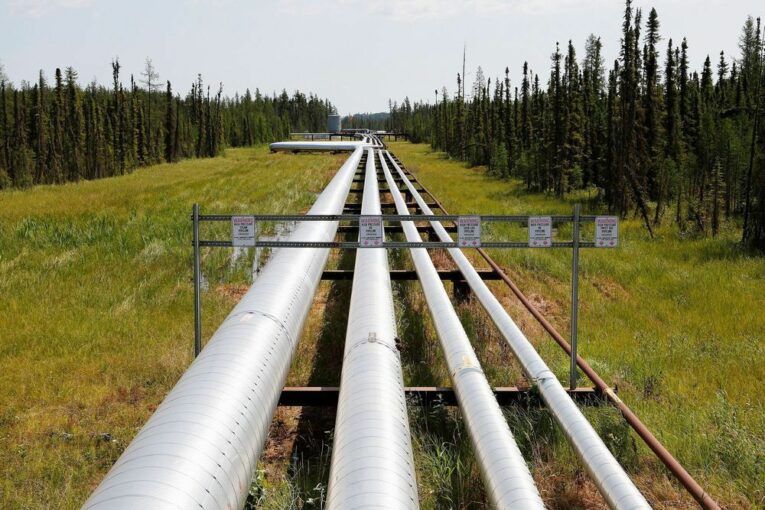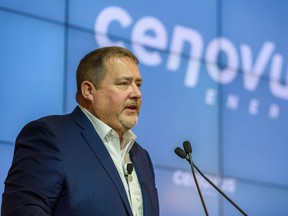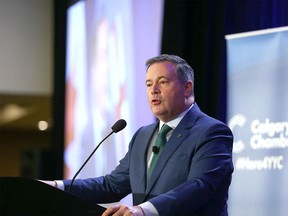
Cenovus Energy has rolled out its plans for the coming year, looking to keep production stable in 2022 and modestly expand its capital spending program.
The integrated petroleum producer also laid out Wednesday its new climate aspirations, striving to lower greenhouse gas emissions by more than a third by 2035 and examine a series of carbon capture projects.
The announcement reflects two key themes for Canadian oilsands operators as they head into 2022: pump out strong cash flow levels and return money to shareholders, but also tackle the emissions challenge facing the sector.
“It’s a two-track system because there is a mandate in place by investors to focus on both,” said analyst Phil Skolnick of Eight Capital.
“They are not the only ones. All of the oilsands producers are focusing on it.”
At its annual investor day, Cenovus announced it will earmark about $2.8 billion towards capital spending next year, up about 12 per cent from 2021 levels. Upstream production is expected to increase by four per cent.
The Calgary-based company will maintain its overall production around 800,000 barrels of oil equivalent per day (boe/d) through its five-year plan.
Some additional spending will be directed next year to its oilsands operations — about $1.45 billion in total — while conventional spending will dip by seven per cent.
“We no longer see the need for major growth phases in our oilsands business,” CEO Alex Pourbaix told analysts, noting the company can add production at its thermal oilsands operations without building expensive new facilities.
“Our plan is set to sustain the increased upstream production we’ve established this year … while also reducing GHG emissions.”
When Pourbaix took over as CEO in 2017, the company was looking at expansion phases at its oilsands operations in northern Alberta that typically would add about 50,000 bpd. These projects would require billion-dollar-plus investments and take five to six years to complete.
Now, Cenovus is able to move steam and oil through pipelines from existing facilities to new oilsands developments up to 20 kilometres away, eliminating the need to construct additional central processing infrastructure.
“It will save us billions of dollars over the years and decades to come,” he told reporters later.

The oilsands producer also highlighted its plans to boost returns to investors through share buybacks and dividends, while it continues to pay down debt.
And the company, which last year adopted a net-zero emissions target for 2050, unveiled a new interim goal, cutting overall emissions by 35 per cent by the end of 2035.
But the bigger, more daunting target is to get to net-zero.
Cenovus is part of a group of six oilsands producers — including Suncor Energy and Imperial Oil — that are working together to reach net-zero emissions from their operations within three decades.
The alliance has proposed building a CO2 trunk line in the province that would connect more than 20 oilsands facilities (mainly in the Fort McMurray area) to an underground carbon storage hub near Cold Lake.
“The unprecedented collaboration … is all about striving to supply the world with net-zero oil production from Alberta,” Imperial Oil CEO Brad Corson said Wednesday at a Calgary Chamber of Commerce luncheon.
The oilsands producers are seeking substantial incentives from Ottawa to proceed with the necessary multi-billion-dollar investments.
The Trudeau government promised in this year’s budget to create a federal tax credit for carbon capture, utilization and storage (CCUS) projects, initially signalling the incentive won’t be available for companies with enhanced oil recovery developments.
“We haven’t made a decision yet on that,” federal Environment Minister Steven Guilbeault said in an interview last week.
The Alberta government is pushing for more than $30 billion in federal incentives over a decade for carbon capture initiatives. It also wants enhanced oil recovery (EOR) projects to be included.
Premier Jason Kenney said Wednesday the federal tax measure must be competitive with a similar enticement in the United States, where the 45Q tax credit has provided companies with a credit of $50 per tonne for CO2 stored underground — and $35 a tonne for EOR developments.
“We have the technology, we have the geology, we have the companies willing to invest,” Kenney told the chamber event.
“But if the federal investment tax for carbon sequestration is significantly less generous than the 45Q … we will see a flow of capital from Canada to the United States.”

Pourbaix, who is the chair of the Canadian Association of Petroleum Producers, also supports including EOR, calling it a cost-effective way for companies to sequester CO2.
With the oilsands concentrated in a small geographic area, this gives Canada an advantage to build large-scale CCUS developments that can serve a number of projects, he added.
“This could very easily be the next boom in the Alberta oil sector — and it’s going to be employment, investment, R&D, all around the decarbonization of the barrel,” Pourbaix said.
Cenovus is also examining three smaller scale carbon capture projects at its existing ethanol plant at Minnedosa, Man., at the Lloydminster heavy oil upgrader and at its Elmworth gas plant in the Grande Prairie area.
Expect to hear a similar discussion from petroleum producers about decarbonization efforts and returning money to investors as other companies unveil their plans for 2022.
With surging cash flow levels and new energy opportunities, consultancy Wood Mackenzie said Wednesday it anticipates global oil and gas companies will invest in low-carbon initiatives at record levels next year.
“It’s clear that sitting on the decarbonization sidelines isn’t an option,” Wood Mackenzie senior vice-president Tom Ellacott said in a statement.
“As stakeholder pressure intensifies, it’s time for big strategic decisions.”
Chris Varcoe is a Calgary Herald columnist.
You can read more of the news on source
